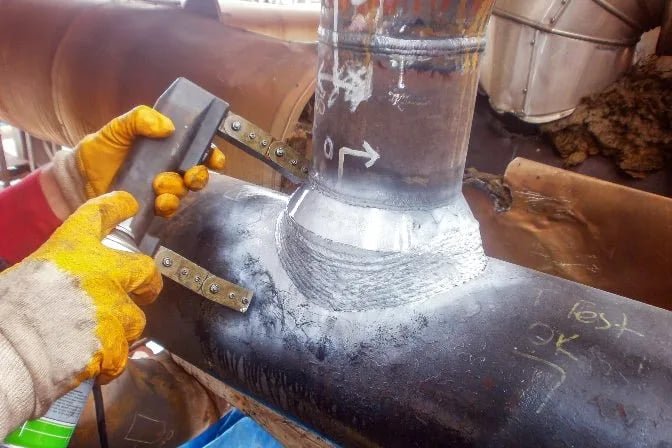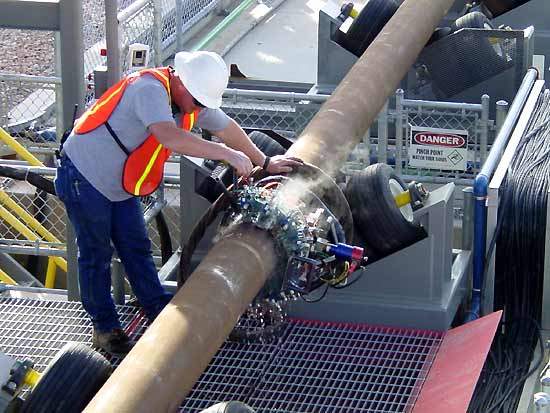Security First: Comprehensive Pipeline Welding Inspection for Every Task Stage
Security First: Comprehensive Pipeline Welding Inspection for Every Task Stage
Blog Article
Taking Full Advantage Of Effectiveness: Pipe Welding Evaluation Ideal Practices
In the realm of pipe building, the honesty and security of bonded joints are vital. Ensuring that welding examinations are performed efficiently and properly can significantly affect the overall high quality of the job. By applying finest practices for pipeline welding assessment, organizations can simplify procedures, reduce mistakes, and enhance task timelines. From using cutting-edge innovation to establishing rigid examination protocols, there are various methods that can be employed to take full advantage of efficiency in this essential element of pipeline construction - Pipeline Welding Inspection. The precise interest to detail needed in welding inspection holds the key to the long-lasting durability and dependability of the pipes, making it a subject of utmost importance in the sector.

Importance of Reliable Welding Inspections
Effective welding assessments play a critical duty in ensuring the architectural integrity and safety and security of pipes. Appropriate examinations are important to determine any type of flaws, stoppages, or imperfections in the bonded joints that might jeopardize the general integrity of the pipeline system. By conducting thorough assessments, assessors can discover concerns beforehand, preventing potential leaks, ruptures, or failings that can have significant environmental and safety effects.
Timely and accurate welding examinations likewise help in preserving compliance with sector requirements and laws. Complying with these criteria is not only a lawful need yet likewise a necessary step to assure the reliability and durability of the pipelines. Effective assessments can add to cost savings by decreasing the demand for pricey repair work or replacements due to welding defects that can have been protected against or remedied throughout the examination process.
Utilizing Modern Technology for Inspections
To enhance the efficiency and precision of pipeline welding evaluations, the combination of innovative modern technologies has come to be increasingly critical in making certain accurate and thorough analyses of bonded joints. Utilizing innovation for assessments supplies numerous benefits, consisting of enhanced performance, boosted precision, and improved precaution. Among the crucial technological advancements in pipe welding assessments is making use of automated ultrasonic screening (AUT) systems. These systems can scan welds swiftly and properly, giving thorough information on potential defects or issues within the weld joint. Furthermore, remote aesthetic inspection (RVI) devices such as robotic crawlers geared up with video cameras allow assessors to accessibility and review difficult-to-reach areas without the requirement for extensive disassembly or manual intervention. Moreover, the application of electronic systems for data evaluation and reporting enhances the assessment procedure, allowing real-time data analysis and seamless paperwork. By embracing these technological options, pipeline welding evaluations can be conducted better, resulting in higher top quality welds, boosted total security, and reduced task timelines.
Establishing Clear Inspection Procedures
Establishing clear evaluation procedures is crucial for ensuring consistency and reliability in the pipe welding examination procedure. These procedures work as a set of standards that outline the details actions, criteria, and techniques to be followed throughout evaluations. By clearly specifying the evaluation methods, all examiners entailed in the procedure can recognize their roles and responsibilities, leading to a much more reliable and standardized assessment workflow.

Normal testimonial and updates to the evaluation procedures are also vital to adjust to altering market criteria and needs. By continuously refining and boosting the procedures based on feedback and lessons found out, pipeline welding evaluations can promote the finest quality requirements and governing conformity.
Training and Qualifications for Inspectors

Training and qualifications for assessors are paramount in making sure the capability and effectiveness of people tasked with managing pipeline welding procedures - Pipeline Welding Inspection. Correctly trained inspectors possess the necessary knowledge and skills to successfully assess weld top quality, adherence to welding treatments, and conformity with industry standards and policies
Accreditations, such as those offered by the American Welding Society (AWS) or the American Oil Institute (API), verify an inspector's know-how and capacity to do assessments to the greatest criteria. These certifications frequently call for rigorous training, evaluations, and continuous expert advancement to make sure that assessors stay current with the current improvements in welding innovation and examination methods.
In addition to official qualifications, continuous training programs play a critical duty in improving inspectors' capabilities. These programs cover a vast array of topics, consisting of welding procedures, flaw detection, security protocols, and appropriate codes and requirements (Pipeline Welding Inspection). By spending in detailed training and certifications for inspectors, companies can promote the honesty of their pipeline welding projects and minimize the dangers related to substandard welds
Continuous Improvement in Inspection Processes
Structure upon the structure of licensed and trained examiners, constant improvement this website in evaluation procedures is important for making sure the ongoing quality and conformity of pipeline welding operations. By implementing a system of continual renovation, pipeline welding evaluation procedures can advance to meet the transforming needs of the sector, technological developments, and regulative requirements. This includes consistently evaluating and reviewing inspection devices, procedures, and methods to identify areas for improvement.
One secret element of continual improvement in evaluation procedures is responses. Collecting input from inspectors, welders, engineers, and various other stakeholders enables for an extensive analysis of present practices and the recognition of prospective areas for renovation. Additionally, leveraging data and analytics can provide valuable insights into the effectiveness of inspection processes, making it possible for educated decision-making for optimization.
Furthermore, purchasing training and growth programs for inspectors can make certain that they are outfitted with the newest knowledge and abilities to perform their responsibilities successfully. Continual enhancement is a dynamic procedure that requires devotion and commitment from all stakeholders to drive excellence in pipe welding examination click over here now methods.
Conclusion
In conclusion, optimizing efficiency in pipe welding evaluations is essential for making certain the high quality and safety of facilities tasks. By making use of modern technology, developing clear methods, supplying correct training and certifications for inspectors, and constantly boosting assessment processes, organizations can streamline their operations and decrease dangers. It is vital for industries to focus on reliable welding assessments to keep high criteria and satisfy regulatory demands.
Efficient assessments can contribute to cost savings by reducing the demand for expensive repair work or replacements due to welding problems that might have been prevented or corrected during the evaluation process.
Establishing clear evaluation protocols is necessary for making sure consistency and reliability in the pipe welding examination process. By clearly defining the evaluation protocols, all inspectors included in the procedure can recognize their duties and responsibilities, leading to an extra reliable and standard examination process.
Clear evaluation methods assist in decreasing the chance of errors or oversights during the inspection process.Building upon the structure of certified and experienced examiners, continuous enhancement in examination click this site procedures is important for guaranteeing the recurring top quality and compliance of pipeline welding operations.
Report this page